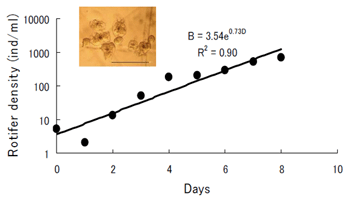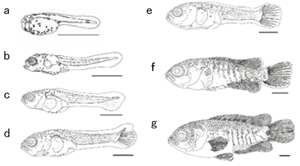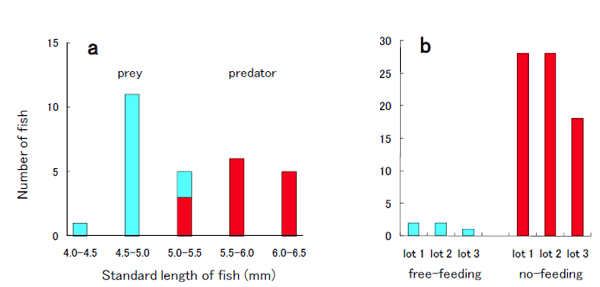Intensive seed production of two Anabantoidei indigenous freshwater fishes in Laos
Description
In Laos, fish aquaculture has been recently promoted due to the necessity of enhancing the overall national food productivity, and its production relatively increased within the last decade. However, the majority (>80%) of aquacultural production is dependent on the alien fish species (e.g., the tilapia and African catfish), and their invasion of the environment is now a strong concern. Accordingly, the aquacultural utilization of indigenous fish species is further required in the aspects of conservation of regional fish diversity and sustainable development of aquaculture, but this has scarcely been undertaken except for limited species (e.g., Barbonymus gonionotus) in the country so far because of insufficient technical information and studies on larval rearing and mass-production of small zooplankton as initial diets for fish larvae. With this background, biological information, which includes sexual maturation and spawning of two Anabantoidei fishes (Anabas testudineus and Trichogaster pectoralis), that are highly in demand as edible fish resources in the region, has been investigated, and the mass-production of freshwater rotifer (Brachionus spp.) has been attempted in order to develop locally adaptable techniques for their seed production in the present study.
By injecting hormone into broodstocks, the fertilized eggs are semi-artificially obtainable in these two species. As initial diet for their larvae, the freshwater rotifer (Brachionus spp.) was artificially cultured in mass quantity using mono-cellular green algae (Chlorella spp.) as diet for the rotifer. The algae were also artificially cultured using locally available common agricultural fertilizers (N:P:K = 15:15:15)(Fig. 1). In addition, it is considered that A. testudineus has a prolonged breeding potential almost throughout the year based on the results of the long-term breeding trial by hormone injection from May, 2007 to February, 2008 and the occurrence of wild juveniles almost throughout the year. The growth rates of the two species under laboratory condition and their morphological / behavioral changes in growth as investigated in the present study (Fig. 2) are the contributory information useful towards improving their seed productivity. In larval and juvenile A. testudineus, intensive cannibalism occurred when their size reached over 5 mm SL. At the onset of cannibalism, the difference in size between the preys and the predators became over 1 mm, and cannibalism is more intensive under poor feeding condition (Fig. 3). Based on these observations, the size-separated culture and feeding management techniques (maintaining high feed density) are efficient in reducing the incidence of cannibalism.
Since both species are air-breathing species, culture at high density without aeration is possible. This feature indicates the applicability of their aquaculture for small scale farmers that do not possess large -scale culture ponds. Although A. testudineus possesses the prolonged breeding potential, the most sustainable period for its seed production is considered to be from May to October because of its lower limit of water temperature requirement being approximately 22.0°C. The diet cost is expected to be higher in the aquaculture of A. testudineus due to the requirement of high protein level in its diet, since the species is highly carnivorous. Accordingly, the development of an economical diet is indispensable. By contrast, T. pectoralis is omnivorous and the low protein level requirement in its diet is useful. This difference in dietary cost suggests the latter to be more suitable for the extension of the aquaculture technique to small scale farmers.
Figure, table
-
Fig. 1.
Mass-cultured rotifer (Photo, scale bar: 0.5 mm, and increase in its density) -
Fig. 2.
Anabas testudineus larvae and juveniles of 0-day (a), 2-days (b), 5-days (c), 7-days (d), 11-days (e), 16-days (f) and 35-days (g) after hatching (scale bar: 1 mm) -
Fig. 3.
a: Difference in sizes between prey and predator at onset of cannibalism (12-days after hatching, mean standard length 5.2±0.6 mm) in A. testudineus larvae, b: Difference in cannibalism incidences between free- and no-feeding conditions.
- Affiliation
-
Japan International Research Center for Agricultural Sciences Fisheries Division
- Term of research
-
FY2008(FY2006~2010)
- Responsible researcher
-
Morioka Shinsuke ( Fisheries Division )
KAKEN Researcher No.: 40455259Vongvichith Bounsong ( Living Aquatic Resources Research Center, Lao PDR )
PHOUNVISOUK Latsamy ( Living Aquatic Resources Research Center )
- ほか
- Publication, etc.
-
Morioka, S., Sakiyama, K. Ito, S. and Vongvichith, B. (2009) Technical report and manual of seed production of the climbing perch Anabas testudineus. JIRCAS Working Report. (in press)
Technical Report and Manual of Seed Production of the Climbing Perch Anabas testudineus
Morioka、S., Ito, S. Kitamura, S. and Vongvichith, B. (2009) Growth and morphological development of laboratory-reared larval and juvenile climbing perch Anabas testudineus. Ichthyol. Res. 56. (in press)
Morioka, S., Phounvisouk, L., Vongvichith, B., Ito, S. and Kitamura, S. (2009) Prolonged breeding potential of the climbing perch Anabas testudineus observed in Laos. Proceedings of the 5th World Fisheries Congress. 61,1-27.
- Japanese PDF
-
2008_seikajouhou_A4_ja_Part24.pdf762.06 KB



